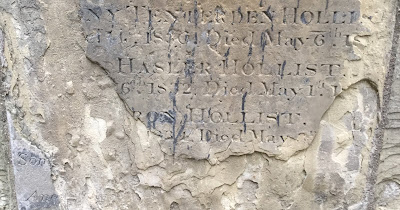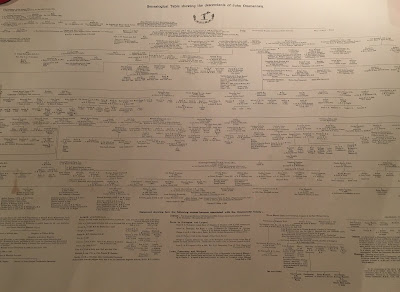Octavius and Helen Ommanney (seated, centre) with, so far as it is possible to tell, many of their direct descendants and their spouses. On the basis of the apparent ages of those who can be identified, as well as Helen’s bouquet which suggests this must have been a significant event, it seems likely that that picture would have been taken at Octavius and Helen’s Golden Wedding Anniversary celebrations in September 1891. If so, it is very likely that it was taken at Bloxham.
2: unknown. My first guess would be Henry George Ommanney Kendall, son of Georgiana, but this feels pretty uncertain. Henry would have been about 25 at this time.
3: unknown, but evidently connected with (2) as they are arm-in-arm. There are no potential missing spouses for Octavius’ and Helen’s sons, and she is too old to be HGO Kendall’s eventual wife, Margaret Nunns, who was born in 1878. An enigma.
4: Sir Montagu Frederick Ommanney, husband (and cousin) of Charlotte (5). In 1891 his career was still a few years away from hitting the heights.
5: Surely Charlotte Helen Ommanney, as she is arm-in-arm with Montagu.
6: Presumably one of the two elder daughters of Montagu and Charlotte, Dorothy (born 1875) or Mildred (born 1877), as her arm is around her mother’s.
7: The Rev. George Campbell Ommanney, taking a day off from his tribulations at Sheffield.
8: By comparison with a much earlier photograph I believe this is Annie Maria Ommanney. It would make sense for her to be in black here, as her second husband, Samuel Sewell, had died in 1890.
9: Again by comparison with another photograph, this time much later, I believe this is Mildred Dunin Ommanney. Both photographs suggest that she was tall.
10: I have seen, but not verified, a suggestion that Edmund Bennett (husband of Mildred Dunin) was at some point in his life a clergyman; if so, this would seem likely to be him. I see little resemblance though with the man in a much later photograph of the couple, except that he is shorter than his wife (though on the evidence of this picture, wasn’t everyone). It also seems odd that he is placed on the right-hand side of the group, which otherwise appears to be reserved for direct descendants.
11, 12: unknown. It seems likely that one of these men would be Henry Broughton Kendall, husband of Georgiana. 12 looks not unlike Charles Henry Ommanney, who is a nephew rather than a direct descendant. Both uncertain.
13, 14: (13) is Ethel Mary Ommanney (née Harrison), wife of Lieut. Robert Nelson Ommanney, who is absent from the picture, presumably at sea. (14) is therefore surely Lawrence Frederick Nelson Ommanney who in September 1891 would have been six months old.
15: unknown, but most likely Emily Sophia, widow of Frederick (who died in June 1889, hence the mourning black). If (1) and (22) really are her daughters, that would strengthen the case for this being Emily – but we are propping up guesses with guesses.
16: A descendant believes this to be Kathleen Helen Ommanney, eldest daughter of Ethel (13). She would be 9 years old here.
17: Octavius Ommanney.
18: Helen Ommanney (née Gream).
19: unknown. On the basis of age, the likely candidates are Gwendoline, younger sister of the most likely candidate for (22), or Helen or Mildred, daughters of Mildred Dunin (see 9 above).
20, 21: On the evidence of the identified children of Octavius and Helen being arranged on the right-hand side of the picture, the two ladies at 20 and 21 are likely to be Georgiana and Octavia, eldest and youngest of the children. Given that Georgiana was born in 1843 and Octavia in 1856, though, it is surprisingly difficult to tell which is which.
22: unknown. Based on apparent age, the only likely candidate amongst the direct
descendants seems to be Margaret, daughter of Frederick
(deceased) and Emily Sophia (candidate for no.15 above). Margaret was 13 in
1891.







